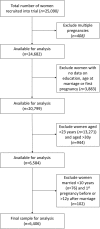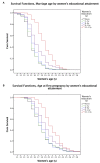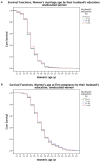How Much Education Is Needed to Delay Women's Age at Marriage and First Pregnancy?
- PMID: 31993411
- PMCID: PMC6964653
- DOI: 10.3389/fpubh.2019.00396
How Much Education Is Needed to Delay Women's Age at Marriage and First Pregnancy?
Abstract
Background: Early childbirth is associated with adverse maternal and child health outcomes. In South Asia, where women generally marry before having children, public health efforts need to focus on delaying marriage. Female education is widely considered the primary means to achieve this. However, it remains unclear how much education is required to delay marriage to the universal minimum age of 18 years, or what predicts marriage age in women lacking any education. This is crucial to address in the Terai region of Nepal which has the highest proportion of children out of school and where girls marry and have their first pregnancy early. Methods: We analyzed data from 6,406 women aged 23-30 years from a cluster-randomized trial in lowland Terai Nepal. Using Kaplan-Meier survival analysis, multivariable logistic and Cox proportional hazards regression models, we investigated associations between women's education level and age at marriage and first pregnancy, and the interval between these events. Among the uneducated women, we investigated associations of husband's education level with the same outcomes. Results: Compared to uneducated women, educated women had a greater probability of delaying marriage until the age of 18 years and of pregnancy until 20 years. Women needed to complete grade 9, and ideally 11, to substantially increase their odds of marrying after 18 years. Delaying first pregnancy to 20 years was largely due to marrying later; education had little extra effect. The association of marriage with first pregnancy age worked independently of education. However, later-marrying women, who generally had completed more education, had their first pregnancy sooner after marriage than earlier marrying women. Most uneducated women, regardless of their husbands' level of education, still married under the legal age of marriage. Conclusion: Delaying marriage to majority age requires greater efforts to ensure girls get to school in the first place, and complete secondary education. Since currently only 36% of girls in the Terai attend secondary school, parallel efforts to delay marriage are crucial to prevent early childbearing. Sexual and reproductive health programmes in school and in women's groups for married and uneducated adolescents may help prepare for marriage and pregnancy.
Keywords: age at first pregnancy; education; lowland Nepal; marriage to first childbearing interval; women's marriage age.
Copyright © 2020 Marphatia, Saville, Amable, Manandhar, Cortina-Borja, Wells and Reid.
Figures






Similar articles
-
Where have I got to? Associations of age at marriage with marital household assets in educated and uneducated women in lowland Nepal.PeerJ. 2024 Aug 7;12:e17671. doi: 10.7717/peerj.17671. eCollection 2024. PeerJ. 2024. PMID: 39131621 Free PMC article.
-
The role of education in child and adolescent marriage in rural lowland Nepal.J Biosoc Sci. 2023 Mar;55(2):275-291. doi: 10.1017/S0021932022000074. Epub 2022 Apr 1. J Biosoc Sci. 2023. PMID: 35361308
-
Quantifying the association of natal household wealth with women's early marriage in Nepal.PeerJ. 2021 Dec 16;9:e12324. doi: 10.7717/peerj.12324. eCollection 2021. PeerJ. 2021. PMID: 35003910 Free PMC article.
-
Women's Marriage Age Matters for Public Health: A Review of the Broader Health and Social Implications in South Asia.Front Public Health. 2017 Oct 18;5:269. doi: 10.3389/fpubh.2017.00269. eCollection 2017. Front Public Health. 2017. PMID: 29094035 Free PMC article. Review.
-
Evidence, hints and assumptions for late pregnancy in the Ancient Mediterranean and Near East.Acta Paediatr. 2023 Jul;112(7):1371-1377. doi: 10.1111/apa.16781. Epub 2023 Apr 10. Acta Paediatr. 2023. PMID: 37002716 Review.
Cited by
-
Do adolescent girls' education and friendships have independent effects on early pregnancy? Results of a mediation analysis from a longitudinal cohort study in Nairobi, Kenya.SSM Popul Health. 2024 Feb 1;25:101618. doi: 10.1016/j.ssmph.2024.101618. eCollection 2024 Mar. SSM Popul Health. 2024. PMID: 38426033 Free PMC article.
-
Prevalence of Ideal Cardiovascular Health Metrics among Young Asian Adults over 5 Years of Follow-Up.Nutrients. 2023 Jan 27;15(3):645. doi: 10.3390/nu15030645. Nutrients. 2023. PMID: 36771352 Free PMC article.
-
Women's empowerment and fertility preferences of married women: analysis of demographic and health survey'2016 in Timor-Leste.AIMS Public Health. 2022 Jan 12;9(2):237-261. doi: 10.3934/publichealth.2022017. eCollection 2022. AIMS Public Health. 2022. PMID: 35634022 Free PMC article.
-
Girls start life on an uneven playing field: Evidence from lowland rural Nepal.Evol Med Public Health. 2022 Aug 4;10(1):339-351. doi: 10.1093/emph/eoac029. eCollection 2022. Evol Med Public Health. 2022. PMID: 35990287 Free PMC article.
-
Prevalence of Teenage Pregnancy and Associated Factors in Agago District, Uganda: A Community-Based Survey.Adolesc Health Med Ther. 2023 Aug 7;14:115-124. doi: 10.2147/AHMT.S414275. eCollection 2023. Adolesc Health Med Ther. 2023. PMID: 37577045 Free PMC article.
References
LinkOut - more resources
Full Text Sources

